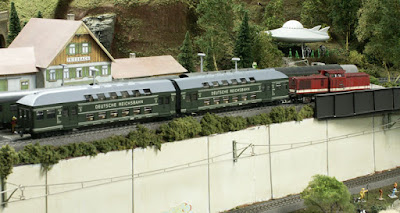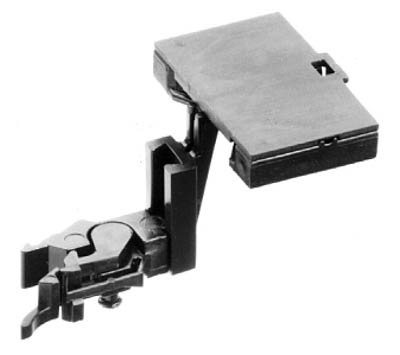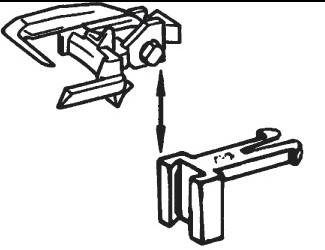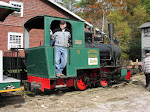18 201 with an express, SVT137, 01.5 with an express, BR114 with a short local and BR132 Ludmilla with a freight.
Showing posts with label H0 Layout. Show all posts
Showing posts with label H0 Layout. Show all posts
Monday, February 2, 2009
Reichsbahn Action
Posted some new videos on YouTube today featuring my Reichsbahn (DR of the DDR) stock. Been a while since I ran some of the consists so they were grateful for being able to roll.
18 201 with an express, SVT137, 01.5 with an express, BR114 with a short local and BR132 Ludmilla with a freight.
18 201 with an express, SVT137, 01.5 with an express, BR114 with a short local and BR132 Ludmilla with a freight.
Saturday, January 31, 2009
Updated Layout Photos
Getting ready to do a big swap of stock on the layout, all DR (Deutsche Reichsbahn of the DDR) for a while so took a bunch of new pictures. That, and the old pics were 3+ years old. Here some samples.
Saturday, January 3, 2009
Gliederzug (articulated train) of the DR
I recently acquired this Sachsenmodelle gliederzug set of the Deutsche Reichsbahn (DR) that was built starting in 1952 by the VEB Waggonbau Görlitz based on pre-war designs of the LBE. More info can also be found in the Wiki. The basic unit was a 4-car bi-level, designated DB13. The axle configuration was 2 + 3 + 3 + 3 + 2, total length 73 400 mm, whereby 2 cars shared a 3-axle bogie.



In the 70s some were reconfigured to run in push-pull operation with the addition of control cabs. The model represents early era 3 before the 2nd and 3rd classes were combined (klassenreform). The car sets could also be found coupled into other consists with "normal" coaches as well.
While the BR 114 diesel in the pictures above post-dates the markings on the coaches, it needs to be understood that this is a "museum" consist owned by the VEB Waggonbau Görlitz and occasionally gets used in regular service. ;-)
To make the model work I replaced the original couplers with a 6574 Fleischmann close-coupling mechanism that is height adjustable and a 40396 Roco Universal coupler head. Installing these required cutting away some bits on the bottom of the end cars as well as an opening between the buffers so the mechanism could pivot. The bellows between the cars are made of paper and are in great shape. Wheels were swapped to 10.4 mm diameter Sachsenmodelle replacement AC wheelsets that brought the unit down to the proper height and really improved running and reliability through turnouts on my Märklin AC layout. The wheels were made by Bernd Thomschke (benno002-2) who sells all types of brass wheels and buffers via his eBay store at<http://stores.ebay.de/benno002-2> or direct at <http://www.modellbahn-radsatz.de>. From the US, the eBay store is easier. Very responsive vendor.
In testing I tried just about every combination I had including some s-curves and tight turnout combinations in the main yard at increasing speeds and went through absolutely smoothly. Night and day difference in running - now completely reliable. It's a nice set, one I look forward to detailing, gently weathering, and most of all running.
Thanks to all the helpful people on the Drehscheibe Online, Railways of Germany, and WorldRailFans, and the Stummi fora.

A two-car configuration, DB7, was also used particularly on branch lines.

While not "normal" 3-car units were occasional run if one of the cars was out of service.

In the 70s some were reconfigured to run in push-pull operation with the addition of control cabs. The model represents early era 3 before the 2nd and 3rd classes were combined (klassenreform). The car sets could also be found coupled into other consists with "normal" coaches as well.
While the BR 114 diesel in the pictures above post-dates the markings on the coaches, it needs to be understood that this is a "museum" consist owned by the VEB Waggonbau Görlitz and occasionally gets used in regular service. ;-)
To make the model work I replaced the original couplers with a 6574 Fleischmann close-coupling mechanism that is height adjustable and a 40396 Roco Universal coupler head. Installing these required cutting away some bits on the bottom of the end cars as well as an opening between the buffers so the mechanism could pivot. The bellows between the cars are made of paper and are in great shape. Wheels were swapped to 10.4 mm diameter Sachsenmodelle replacement AC wheelsets that brought the unit down to the proper height and really improved running and reliability through turnouts on my Märklin AC layout. The wheels were made by Bernd Thomschke (benno002-2) who sells all types of brass wheels and buffers via his eBay store at<http://stores.ebay.de/benno002-2> or direct at <http://www.modellbahn-radsatz.de>. From the US, the eBay store is easier. Very responsive vendor.
 |
| 6574 Fleischmann |
 |
| 40396 Roco |
In testing I tried just about every combination I had including some s-curves and tight turnout combinations in the main yard at increasing speeds and went through absolutely smoothly. Night and day difference in running - now completely reliable. It's a nice set, one I look forward to detailing, gently weathering, and most of all running.
Thanks to all the helpful people on the Drehscheibe Online, Railways of Germany, and WorldRailFans, and the Stummi fora.
In the video below a BR78 steam engine is pulling the consist.
For better quality video view it on YouTube.
For better quality video view it on YouTube.
Thursday, January 1, 2009
Running trains
Decided to take a break from the modeling activities of the past few days to actually run trains... Below are some videos, with more (and higher playback quality possible) on the Papphausen2 site at YouTube. Actually getting better at filming and editing, but it is very hard to hold a camera with one hand, and control the trains with the other, especially when there are turnouts and signals to be operated... Still good fun.
While the BR 151 of the Deutsche Bundesbahn (DB) was designed to replace the BR 150 electric in heavy freight service such as unit trains carrying ore, coal, or tank cars, it occasionally saw service pulling passenger trains, especially in hilly country where its lower speed would not be a factor.
A BR 10 of the Deutsche Bundesbahn (DB), the last heavy steam passenger engine built and one of only two, pulls a rake that includes early bi-level coaches. In 1950, the (DB) had a small batch of bi-level coaches built. The first were 22.5 meters long. A second batch that was made in 1951 were 26.4 meters long, the new UIC (International Union of Railways) standard coach length. Bi-level coaches were not something that was new in Germany with the first having been developed by the Lübeck-Büchener Eisenbahn (LBE) in the 1920s. These were used with tank engines outfitted for push-pull operation.
These new coaches were used to test the new high-speed Minden-Deutz bogies and rubber car end seals, with the second also being used to test new openable window constructions.
While bi-level coaches never took off with the DB, the DR in East Germany embraced them at about the same time, something which may have contributed to the non-adoption of the design in the West. Before and with reunification of the German railways in 1989, the DB began to purchase large numbers of modern bi-level coaches from the East, using them in local and regional service.
Below an advertising film of the DB introducing the new bi-level cars with lots of construction footage
BR 151 electric pulling an express in hilly terrain.
While the BR 151 of the Deutsche Bundesbahn (DB) was designed to replace the BR 150 electric in heavy freight service such as unit trains carrying ore, coal, or tank cars, it occasionally saw service pulling passenger trains, especially in hilly country where its lower speed would not be a factor.
BR 10 of the Deutsche Bundesbahn (DB) with bi-level passenger coaches.
A BR 10 of the Deutsche Bundesbahn (DB), the last heavy steam passenger engine built and one of only two, pulls a rake that includes early bi-level coaches. In 1950, the (DB) had a small batch of bi-level coaches built. The first were 22.5 meters long. A second batch that was made in 1951 were 26.4 meters long, the new UIC (International Union of Railways) standard coach length. Bi-level coaches were not something that was new in Germany with the first having been developed by the Lübeck-Büchener Eisenbahn (LBE) in the 1920s. These were used with tank engines outfitted for push-pull operation.
These new coaches were used to test the new high-speed Minden-Deutz bogies and rubber car end seals, with the second also being used to test new openable window constructions.
While bi-level coaches never took off with the DB, the DR in East Germany embraced them at about the same time, something which may have contributed to the non-adoption of the design in the West. Before and with reunification of the German railways in 1989, the DB began to purchase large numbers of modern bi-level coaches from the East, using them in local and regional service.
Below an advertising film of the DB introducing the new bi-level cars with lots of construction footage
Branchline action on my layout.
BR 132 Ludmilla of the Deutsche Reichsbahn (DR) pulling a freight.
Subscribe to:
Posts (Atom)






